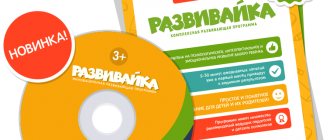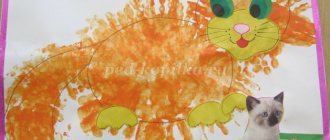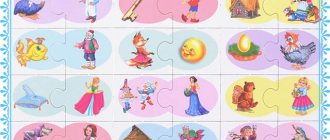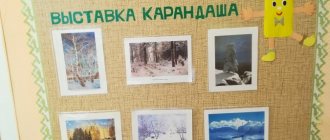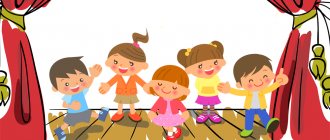Program of the physical education and health club “Healthy Guy”
Explanatory note
Man is the highest creation of nature. But in order to enjoy its treasures, he must meet at least one requirement: to be healthy and good at sports.
According to the World Health Organization,
health is the natural state of the body, characterized by its balance with the environment and the absence of any painful changes; a state of complete physical, mental and social well-being.
The preschool period is an extremely important stage in a child’s life.
A child is born helpless, with the only ability to learn everything over time. He is not born with a ready-made set of movements, but masters them in the process of life.
Movement training has an impact on the health, general physical development, development of cognitive abilities, volitional qualities, emotionality of the child, i.e. to his inner world. Movement training contributes to the harmonious development of personality, improvement of both physical and mental, intellectual, spiritual and moral qualities.
By learning movements, a child acquires the knowledge necessary for his conscious motor activity and gains experience in their implementation, including creative ones.
Learning movements contributes to the child’s awareness of himself as an individual, develops in him the need to improve his own nature, and creates the prerequisites for the realization of his individuality. By performing a variety of movements, the child gets the opportunity to improve himself, and an interest and love for physical education is formed.
The program is aimed at developing in a small child an interest in his personal health, improving all types of movements and developing physical qualities.
Program features:
- Considered under the health aspect.
- The emphasis of health-improving work is on the development of the child’s motor activity.
- Classes are structured taking into account age criteria.
- Use of small forms of folklore.
- It is carried out in close cooperation with the families of the pupils.
Goals and objectives of the program:
Goal: increasing children’s physical fitness and health level while simultaneously developing their mental abilities.
Tasks:
- maintaining and strengthening children's health;
- formation of healthy lifestyle habits;
- formation of motor skills and abilities;
- development of psychophysical qualities (speed, strength, endurance, flexibility, agility);
- development of motor abilities (balance functions, coordination of movements);
- prevention of musculoskeletal disorders, colds;
- formation of the need for daily physical activity;
- development of attention, concentration, organization,
- imagination, fantasy, ability to control one’s actions and feelings.
To fulfill the health-improving and educational objectives of the program, the following structures are provided:
- Corrective, rhythmic, logorhythmic gymnastics
- Dynamic and health breaks
- Relaxation exercises
- Round dances, various types of games
- Entertaining warm-ups
- Various types of massage
- Finger gymnastics
- Breathing exercises
To successfully implement program tasks, content classes are used:
- Traditional
- Circuit training
- Gaming
- Activities - travel
- Educational
- Cognitive
Principles of program construction:
The principle of systematicity and consistency presupposes the interconnection of knowledge, skills and abilities.
The principle of connecting theory with practice develops in children the ability to apply their knowledge of maintaining and promoting health in everyday life.
The principle of repetition of skills is one of the most important, since as a result of repeated repetitions, dynamic stereotypes are developed.
The principle of individual-personal orientation of education assumes that the main goal of education is the child, and not the world around him. The teacher, based on the child’s individual characteristics, plans his development, outlines ways to improve skills and abilities, and build a motor regime.
The principle of accessibility allows us to eliminate harmful consequences for children’s bodies as a result of excessive demands and physical activity.
The principle of success is that at the first stage of health development, the child receives tasks that he is able to successfully complete.
The principle of active learning obliges us to build the learning process using active forms and methods of teaching that promote the development of independence, initiative and creativity in children (game technologies, work in pairs, subgroups, individually, organization of research activities, etc.).
The principle of communication helps to instill in children the need for communication, in the process of which social motivation for health is formed.
The principle of interaction between kindergarten and family, continuity during the transition to school is aimed at creating conditions for more successful realization of the child’s abilities and ensuring the possibility of maintaining health during further education at school.
The principle of effectiveness involves obtaining a positive result of health-improving work, regardless of the age and level of physical development of children.
Principles of interaction with children:
- the child himself is a great guy, everything works out for him, the difficulties that arise are surmountable;
- constant encouragement of all the efforts of the child, his desire to learn something new and learn new things;
- exclusion of negative assessment of the child and the results of his actions;
- comparison of all the child’s results only with his own, and not with the results of other children;
- Each child must progress at his own pace and with continued success.
Program implementation period – 1 year:
— once a week
– duration – 30 minutes
– per month – 4 lessons – 2 hours
– number of children – 12-14, age 5-7 years
Methodological support of the program:
- Classes in this program consist of practical activities for children.
- Conducted under the guidance of a teacher.
Forms and methods of teaching:
- Verbal – explanation;
- Visual – display, books, illustrations;
- Search engines – search for new ideas, materials;
- Creative – creative approach.
Program effectiveness:
— Development of physical qualities of preschool children through sports and recreational work.
— Increasing the level of physical fitness (increase in indicators of the development of physical qualities).
— Varied, exciting, joint activities with children provide physical activity for children and contribute to their emotional uplift.
Forward planning:
| month | Program tasks | |||||
| October | To develop in children the ability to objectively assess their physical capabilities in order to act competently in unusual situations from the point of view of danger or safety of performing certain actions. | |||||
| 1 Week | 2 week | 3 week | 4 week | |||
| Give an idea that opportunities and desires do not always coincide | To form an idea of the limits of physical capabilities, the ability to assess a situation according to the principle “dangerous - safe” | Continue to form an idea of the limits of your capabilities (in long jumps, high jumps), the ability to assess the situation | Develop the ability to predict the results of other people’s actions and evaluate their capabilities | |||
| November | — Provide a general strengthening effect on the child’s body; — Form correct posture; — Develop attention and coordination of movements. | |||||
| Strengthening the skills of correct posture | Prevention of scoliosis | Posture correction | ||||
| December | — Form correct gait and posture in children — Teach how to perform exercises to strengthen the muscles involved in the formation of the arch of the foot. | |||||
| General developmental exercises for flat feet | Strengthening the muscles involved in the formation of the foot | “Funny legs” - useful exercises for the feet | “Strengthen your leg muscles for long and difficult roads” | |||
| January | Strengthen the musculoskeletal system of children using corrective exercises. | |||||
| Improving the functions of the vestibular apparatus | Strengthening the muscular corset of the spine | Coordination of movements of the upper and lower extremities | Strengthening the ligamentous-muscular system of the torso and limbs | |||
| February | — Develop and correct the cognitive, emotional and personal sphere of the child’s psyche using elements of psycho-gymnastics; — Develop memory, attention, will, imagination, develop creative abilities. | |||||
| Journey to a fairy planet | On the seashore | forest path | We are funny animals | |||
| March | Ball school Master the technique of playing with the ball. | |||||
| Throw the ball up and catch it, hit the ball with one hand | Hit the ball with your right and left hand on the spot; dribble while walking | Exercises using fitballs | ||||
| April | — Increase children’s physical activity using exercise machines and non-standard equipment; — Improve the ligamentous-articular apparatus. | |||||
| Use of rope | Walking barefoot on bags of pebbles | Dry pool exercises | Exercise equipment | |||
| May | Independent activity of children. — Teach children to use acquired knowledge and developed skills; - Be able to independently engage in physical exercises and use sports equipment as intended. | |||||
Literature:
1. Varenik E.N. Physical education and health activities for children aged 5-7 years. M., “TC Sfera”, 2006
2. Gavryuchina L.V. Health-saving technologies in preschool educational institutions. Methodological manual, M., “TC Sfera”, 2007.
3. Golitsyna N.S. Non-traditional physical education classes in a preschool educational institution. M., Publishing House Scriptorium 2003, 2006.
4. Orel V.I., Agadzhanova S.N. Health-improving work in preschool educational institutions. Textbook, St. Petersburg, “Childhood-press”, 2006.
5. Saykina E.G., Firileva Zh.E. Physical education - hello to minutes and pauses! Methodological manual, St. Petersburg, “Childhood-press”, 2006.
6. Stepanenkova E. Methods of physical education. M., Publishing House "Education of Preschool Children", 2005.
7. Utrobina K.K. Entertaining physical education in kindergarten for children 5-7 years old. Textbook, M., “Gnome and D.”, 2008
Work program for the “Sports Carousel” circle
1.
Explanatory note.
Motor activity is not only a feature of highly organized living matter, but also in the most general form of the movement of matter is a necessary condition for life itself.
If a child is limited in this natural need, his natural inclinations gradually lose their significance. Inactivity destroys both soul and body! Limitation of physical activity leads to functional and morphological changes in the body and a decrease in life expectancy. Nature does not forgive disregard for its laws.
Movement is one of the main conditions for the existence of the animal world and progress in its evolution. The activity of skeletal muscles determines the reservation of energy resources, their economical expenditure under resting conditions and, as a consequence, an increase in life expectancy.
Among the factors of maintaining and strengthening health, the leading role belongs to physical culture and various means of increasing physical activity.
The high level of physical and mental performance of people involved in physical exercise lasts much longer than that of those who do not exercise. A decrease in active physical activity has a detrimental effect on health. First of all, it contributes to the development of cardiovascular diseases and leads to metabolic disorders. Physical exercise prevents atherosclerotic changes in blood vessels and reduces the risk of coronary heart disease.
The ability to counteract changes in the internal environment of the body that accompany physical exercise is a specific property of a trained organism: a person acquires a reliable ability to actively fight pathogenic agents of the external environment.
The health-improving and preventive effect of physical education is inextricably linked with increased physical activity, strengthening of the functions of the musculoskeletal system, and activation of metabolism. It is also important to increase the body’s resistance to the effects of unfavorable environmental factors: stressful situations, high and low temperatures, radiation. Injuries, hypoxia. As a result of increased nonspecific immunity, resistance to colds also increases.
Purpose
The program of additional education for children “Sports Carousel” is the comprehensive physical development of a person and the improvement of motor, moral and volitional qualities of the individual.
Main tasks
"Sports Carousel" programs are:
1. Strengthening the health of schoolchildren;
2. Promoting the proper physical development of the child’s body;
3. Acquisition by students of the necessary theoretical knowledge;
4. Developing willpower, perseverance, discipline, cultural behavior skills, and a sense of friendship among students;
5. Instilling organizational skills in students.
The most important didactic principles
learning are consciousness and activity, visibility, accessibility, individualization, systematicity, consistency, strength. The main task of a teacher of additional education is the ability to correctly combine the principles of teaching in the classroom, depending on the age of the students, their individual abilities to assimilate educational material and character traits.
Leading methods
training recommended by this program are:
– verbal methods that create in students a preliminary idea of the movement being studied. For this purpose it is recommended to use: explanation; story; comments; teams; orders; instructions; counting, etc.;
– visual methods – are used mainly in the form of showing exercises, educational visual aids, and videos. These methods help students develop concrete ideas about the activities being studied;
– practical methods: exercise method, competitive method. The main thing is the method of exercise, which involves repeated repetition of movements. Learning exercises is carried out in two ways: - in general; - in parts.
The physical training methodology for the “Sports Carousel” program is based on the concept of training as a scientifically based theory of managing the increase in the physical potential of schoolchildren. A high level of development of motor qualities and abilities, general and physical performance can be acquired by pupils through training, through the implementation of a targeted process of adapting them to motor activity of the required volume and sufficient intensity.
The “Sports Carousel” program is designed for 1 year, 1 hour per week (37 hours in total). Everyone is recruited for training, 1st grade students who do not have medical contraindications for classes
Relevance of the program.
Physical culture and sports are a vast pedagogical space. The great Greek philosophers Socrates, Plato, Aristotle and others paid attention to the unique possibilities of sports activities in the education of an integral, versatile personality.
The genetic program of each person initially contains a huge margin of safety, but it is known that now the health of the Russian population, especially young people, leaves much to be desired. This is due to the presence of an ever-deepening contradiction between the increased adaptive-somatic, psychological and genetic capabilities of modern man, on the one hand, and the sharp decrease in his motor activity as a regulator of the states and functions of the body, on the other. All the more important is the importance of physical education classes at school as the most important part of the entire program for improving the health of the population, promoting health, creating a reliable foundation in childhood and adolescence for a future long and healthy life. We consider group work to be an important means of physical education.
We consider physical training in the system of physical culture and sports education of children as a specialized process of using physical exercises in order to develop and improve the properties and abilities that determine the formation of motor skills and physical qualities of schoolchildren.
In addition, the relevance of the physical culture and sports activity is determined by the fact that in childhood motor skills develop most intensively, since during this period the formation of the entire motor apparatus and physical qualities occurs. Weak, inharmonious development of the muscular system significantly delays the development of the child’s motor abilities.
In the process of modeling the educational system of a sports and recreational club, we needed to determine the main components
systemic education. To do this, we analyzed the scientific and methodological literature on this problem, as well as the well-known practice of using a systematic approach in educational activities and the application of theoretical research methods. As a result of the work done, we were able to identify the following components of the educational system of the sports and fitness club, which we consider the most significant and important:
-Value-orientation component;
– Functional-activity component;
– Spatio-temporal component;
– Diagnostic and analytical component
2. Thematic plan of the program
| № | Name of sections, blocks, topics | Total, hour | Number of hours | Characteristics of students' activities | |
| Classroom | Extracurricular | ||||
| 1 | Theoretical knowledge | ||||
| 1.1 | Rules of conduct in the gym and on the sports ground | 1 | 1 | Get to know the teacher and classmates. Acquire the necessary theoretical knowledge. | |
| 1.2 | Self-control | 1 | 1 | ||
| 1.3 | Hygiene, medical supervision, injury prevention. | 1 | 1 | ||
| 1.4 | The importance of morning exercises and hardening. | 1 | 1 | ||
| 2 | Sports and recreational activities | ||||
| 2.1 | Athletics | 7 | 7 | Perform various physical exercises. They improve coordination of movements, work on balance, strengthen muscles through exercises. Will, perseverance, discipline, and cultural behavior skills are developed. Strengthens physical and mental health. | |
| 2.1.1 | Types of walking and running | 2 | 2 | ||
| 2.1.2 | Shuttle run | 2 | 2 | ||
| 2.1.3 | Running relay races | 2 | 2 | ||
| 2.1.4 | High start | 1 | 1 | ||
| 2.2 | Outdoor games based on sports. BASKETBALL | 8 | 8 | ||
| 2.2.1 | Stances and movements | 2 | 2 | ||
| 2.2.2 | Catching and passing the ball | 2 | 2 | ||
| 2.2.3 | Dribbling | 2 | 2 | ||
| 2.2.4 | Ball Throw | 2 | 2 | ||
| 2.3 | Outdoor games based on sports. VOLLEYBALL | 8 | 8 | ||
| 2.3.1 | Racks and movements | 3 | 3 | ||
| 2.3.2 | Receiving and passing the ball | 3 | 3 | ||
| 2.3.3 | Bottom feed | 2 | 2 | ||
| 2.4 | Gymnastics | 8 | 8 | ||
| 2.4.1 | Acrobatic exercises | 4 | 4 | ||
| 2.4.2 | Coordination exercises | 4 | 4 | ||
| Total: | 37 | 4 | 33 | ||
3. Contents of the program.
Theoretical classes
Topic: “Rules of conduct in the gym and on the sports field.” 1 hour.
The history of the emergence of shaping as a type of health-improving gymnastics. Development of shaping abroad. Development of shaping in Russia.
Topic: “Self-control”. 1 hour.
Athlete's self-control. The concept of sports form, training, fatigue and overtraining. Measures to prevent fatigue. Objective self-monitoring data: pulse, blood pressure; subjective data: well-being, sleep, appetite, performance.
Topic: “Hygiene, medical supervision, injury prevention.” 1 hour.
Compliance with sanitary and hygienic standards during shaping classes. Uniform, shoes for classes. Passing medical examination as a necessary condition for maintaining health. Safety instructions during classes.
Topic: “The importance of morning exercises and hardening.” 1 hour.
Daily regime. Vitamins and their importance in nutrition. Using natural factors (sun, air and water) to harden the body..
Sports and recreational activities
Topic: “Athletics”. 7 hours.
Development of speed abilities:
relay races; starts from various positions; running with acceleration; with maximum speed over a distance of up to 60 m; running with changes in direction, pace, rhythm; from different starting positions.
Development of speed and strength abilities:
various jumps, multi-jumps; exercises with weights at an increased pace.
Topic: “Outdoor games based on sports. Basketball.8h.
Familiarization with the basic elements of technique, tactics and rules of the game of basketball. Two-sided games with simplified rules.
Ball games; running games; jumping, resistance elements; games with arranging and collecting objects, carrying loads, jumping and running, balance exercises, jumping ropes, elements of sports games, combined relay races.
Topic: “Outdoor games based on sports. Volleyball.”8h.
Familiarization with the basic elements of technique, tactics and rules of the game of volleyball. Two-sided games with simplified rules.
Ball games; running games; jumping, resistance elements; games with arranging and collecting objects, carrying loads, jumping and running, balance exercises, jumping ropes, elements of sports games, combined relay races.
Topic: “ Gymnastics” 8 hours.
Acrobatics - somersaults forward and backward, stand on the shoulder blades, bending upward jump; Low crossbar – hanging while standing. Jumping rope. Exercises to develop flexibility. Exercises to develop coordination.
4. Expected results of the program implementation
Performance indicators
programs are:
– increasing the role of athletic training. Its focus is determined by the morphofunctional and psychological characteristics of schoolchildren, and is used depending on the stage of preparation in developmental, supportive and compensatory modes;
– increasing the effectiveness of classes;
– specialization of all means of training students.
Main factors
, which determine
the effectiveness
of students’ physical activity based on the results of the implementation of the “Sports Carousel” program, are:
– Social personality traits, motivation for physical activity;
– Improved coordination;
– General and special physical preparedness;
– Psychological preparedness;
– Indicators of mental processes;
– Features of temperament, emotional-volitional sphere, typological properties of the nervous system;
– Favorable functional state based on good health;
– Anthropometric readings;
– Age and experience of physical activity.
Special training hours are allocated for conducting control tests. Based on the results of control tests, it is recommended to make operational adjustments to the educational process, as well as to resolve the issue of the level of preparedness of students.
During the implementation of the program, students are expected to achieve the second level of results.
Second level of results:
Conscious attitude towards your own health. Mastering available ways to strengthen it.
Formation of the need for daily physical activity.
Development of coordination, agility, speed, flexibility, strength, general endurance.
Control standards
| Age, years | Level of readiness | ||
| high | average | short | |
| Flexion and extension of the arms from the standing position - lying position | |||
| 8 | 16 | 13 | 10 |
| 7 | 14 | 11 | 8 |
| Raising the body from the I.P. - lying on your back, hands behind your head for 30 seconds | |||
| 8 | 20 | 17 | 14 |
| 7 | 18 | 15 | 12 |
| Raising the torso from the I.P. - lying on the stomach, hands behind the head | |||
| 8 | 13 | 10 | 7 |
| 7 | 11 | 8 | 5 |
| Squats | |||
| 8 | 30 | 26 | 22 |
| 7 | 27 | 23 | 20 |
| Squatting emphasis - lying emphasis for 30 seconds | |||
| 8 | 25 | 22 | 19 |
| 7 | 23 | 20 | 15 |
5. Forms and types of control.
Studying this course will allow children to gain a general understanding of general physical fitness, teach them to control their body, analyze their well-being during and after physical activity (self-control), and return functional indicators (pulse, breathing rate) to their normal state.
Control is passing the standards. Performance at school and other competitions in various sports.
6. Methodological recommendations
The teacher must provide each student with equal access to the basics of physical education, relying on broad and flexible methods and means for the development of children with different levels of motor and mental abilities.
During classes, it is necessary to use individual and additional tasks more often in order to eliminate certain shortcomings in the technique of mastering basic techniques in the development of certain motor abilities.
Among the ways to organize students in classes, it is advisable to more often use the method of circular training, using exercises with a ball aimed at developing specific coordination and conditioning abilities and improving basic techniques.
An important condition for the successful work of a teacher is competent planning of program material, giving this type of educational activity non-standard, non-traditional, original techniques that activate all students and create a beneficial environment for interaction. It is necessary to teach a child to learn, to preserve his talent, his strength, and to cultivate his will.
7. Description of the material and technical support of the program.
| No. | Name of facilities and means of logistical support | Quantity |
| 1.Library collection (book and printed products)* | ||
| 1. | A.A. Guzhalovsky “The stages of development of physical (motor) qualities and the problem of optimizing the physical training of school-age children.” – Author's abstract. dis. doc. ped. Sci. – M.: 1979. | 1 |
| 2. | G.P. Salnikov “Physical development of children.” – M.: Education, 1968. | 1 |
| 3. | D.V. Shadrikov "Activity and abilities." – M.: Logos, 1994. | 1 |
| 2. Printed manuals | ||
| 1. | Exercise Cards | 20 |
| 3. Technical training aids | ||
| 4. | Computer | 1 |
| Multimedia projector | 1 | |
| Screen for projector | 1 | |
| 4. Screen and sound aids | ||
| 1. | DVDs with training recordings. | 5 |
| 2. | Music Center | 1 |
| 6. Gym equipment | ||
| Gymnastic mats | 10-20 | |
| Basketballs | 10 | |
| Volleyballs | 10 | |
| Gymnastic benches | 2 | |
| Jump ropes | 10-20 | |
